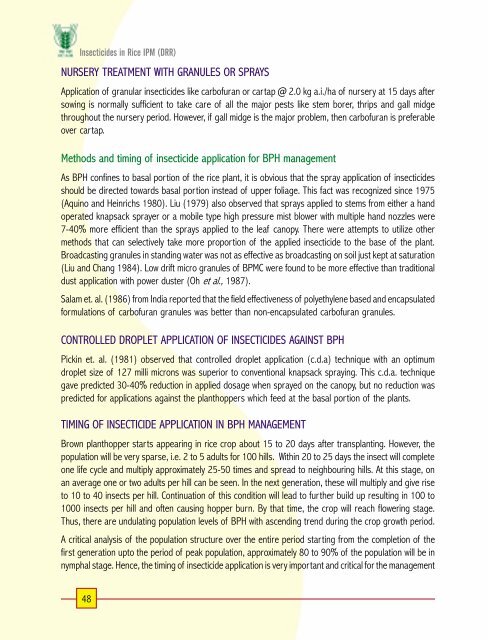priciples of insecticide use in rice ipm
priciples of insecticide use in rice ipm
priciples of insecticide use in rice ipm
Create successful ePaper yourself
Turn your PDF publications into a flip-book with our unique Google optimized e-Paper software.
Insecticides <strong>in</strong> Rice IPM (DRR)<br />
NURSERY TREATMENT WITH GRANULES OR SPRAYS<br />
Application <strong>of</strong> granular <strong><strong>in</strong>secticide</strong>s like carb<strong>of</strong>uran or cartap @ 2.0 kg a.i./ha <strong>of</strong> nursery at 15 days after<br />
sow<strong>in</strong>g is normally sufficient to take care <strong>of</strong> all the major pests like stem borer, thrips and gall midge<br />
throughout the nursery period. However, if gall midge is the major problem, then carb<strong>of</strong>uran is preferable<br />
over cartap.<br />
Methods and tim<strong>in</strong>g <strong>of</strong> <strong><strong>in</strong>secticide</strong> application for BPH management<br />
As BPH conf<strong>in</strong>es to basal portion <strong>of</strong> the <strong>rice</strong> plant, it is obvious that the spray application <strong>of</strong> <strong><strong>in</strong>secticide</strong>s<br />
should be directed towards basal portion <strong>in</strong>stead <strong>of</strong> upper foliage. This fact was recognized s<strong>in</strong>ce 1975<br />
(Aqu<strong>in</strong>o and He<strong>in</strong>richs 1980). Liu (1979) also observed that sprays applied to stems from either a hand<br />
operated knapsack sprayer or a mobile type high pressure mist blower with multiple hand nozzles were<br />
7-40% more efficient than the sprays applied to the leaf canopy. There were attempts to utilize other<br />
methods that can selectively take more proportion <strong>of</strong> the applied <strong><strong>in</strong>secticide</strong> to the base <strong>of</strong> the plant.<br />
Broadcast<strong>in</strong>g granules <strong>in</strong> stand<strong>in</strong>g water was not as effective as broadcast<strong>in</strong>g on soil just kept at saturation<br />
(Liu and Chang 1984). Low drift micro granules <strong>of</strong> BPMC were found to be more effective than traditional<br />
dust application with power duster (Oh et al., 1987).<br />
Salam et. al. (1986) from India reported that the field effectiveness <strong>of</strong> polyethylene based and encapsulated<br />
formulations <strong>of</strong> carb<strong>of</strong>uran granules was better than non-encapsulated carb<strong>of</strong>uran granules.<br />
CONTROLLED DROPLET APPLICATION OF INSECTICIDES AGAINST BPH<br />
Pick<strong>in</strong> et. al. (1981) observed that controlled droplet application (c.d.a) technique with an optimum<br />
droplet size <strong>of</strong> 127 milli microns was superior to conventional knapsack spray<strong>in</strong>g. This c.d.a. technique<br />
gave predicted 30-40% reduction <strong>in</strong> applied dosage when sprayed on the canopy, but no reduction was<br />
predicted for applications aga<strong>in</strong>st the planthoppers which feed at the basal portion <strong>of</strong> the plants.<br />
TIMING OF INSECTICIDE APPLICATION IN BPH MANAGEMENT<br />
Brown planthopper starts appear<strong>in</strong>g <strong>in</strong> <strong>rice</strong> crop about 15 to 20 days after transplant<strong>in</strong>g. However, the<br />
population will be very sparse, i.e. 2 to 5 adults for 100 hills. With<strong>in</strong> 20 to 25 days the <strong>in</strong>sect will complete<br />
one life cycle and multiply approximately 25-50 times and spread to neighbour<strong>in</strong>g hills. At this stage, on<br />
an average one or two adults per hill can be seen. In the next generation, these will multiply and give rise<br />
to 10 to 40 <strong>in</strong>sects per hill. Cont<strong>in</strong>uation <strong>of</strong> this condition will lead to further build up result<strong>in</strong>g <strong>in</strong> 100 to<br />
1000 <strong>in</strong>sects per hill and <strong>of</strong>ten caus<strong>in</strong>g hopper burn. By that time, the crop will reach flower<strong>in</strong>g stage.<br />
Thus, there are undulat<strong>in</strong>g population levels <strong>of</strong> BPH with ascend<strong>in</strong>g trend dur<strong>in</strong>g the crop growth period.<br />
A critical analysis <strong>of</strong> the population structure over the entire period start<strong>in</strong>g from the completion <strong>of</strong> the<br />
first generation upto the period <strong>of</strong> peak population, approximately 80 to 90% <strong>of</strong> the population will be <strong>in</strong><br />
nymphal stage. Hence, the tim<strong>in</strong>g <strong>of</strong> <strong><strong>in</strong>secticide</strong> application is very important and critical for the management<br />
48











